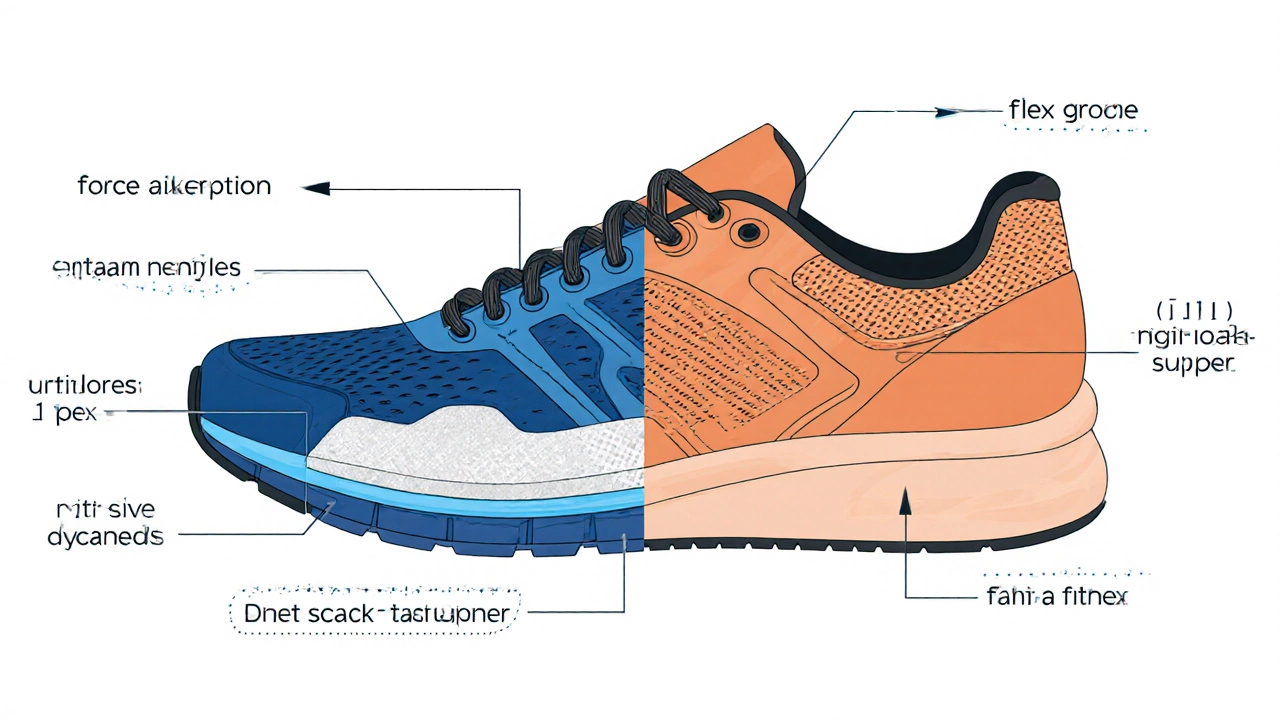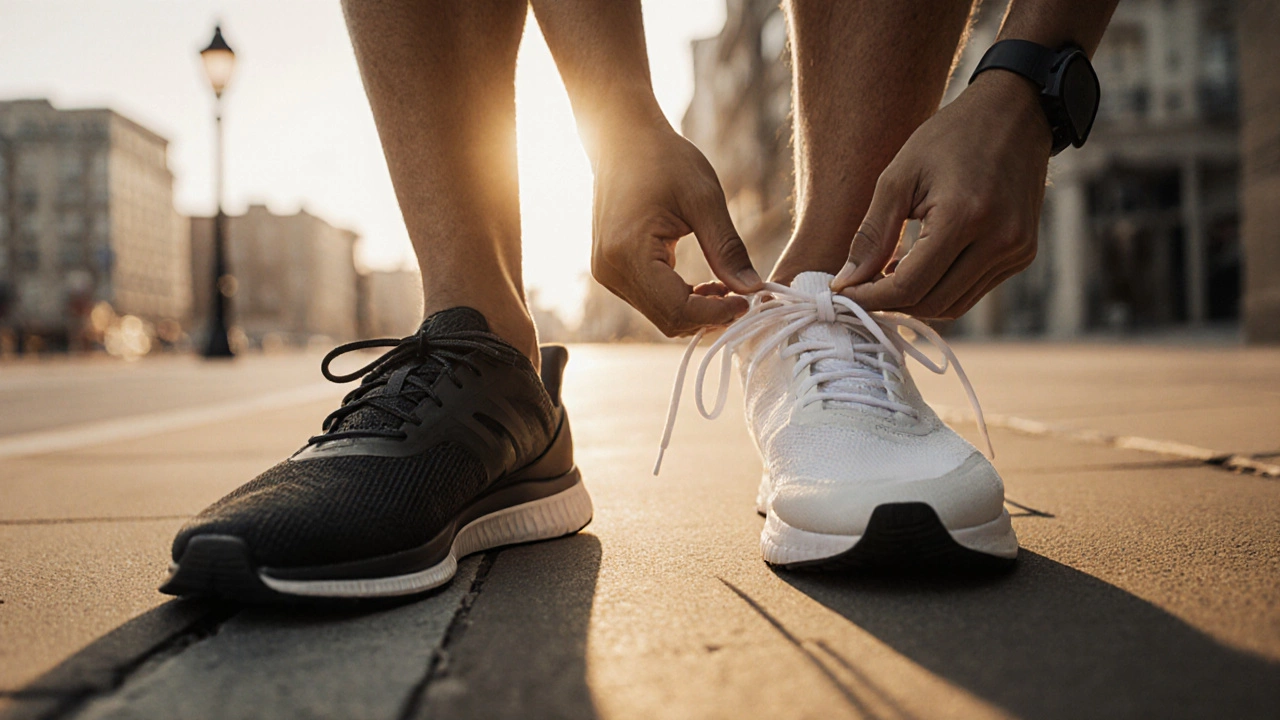Running Shoe Suitability Calculator
Get Your Running Shoe Safety Assessment
Enter your running details to see if your regular sneakers are safe to use or if you should invest in proper running shoes.
Enter your running details above and click "Assess My Safety" to see your result.
When you lace up for a jog, the first question that pops into many minds is whether running shoes are truly necessary or if the trusty pair of Regular sneakers will do the job. The short answer: you can jog in everyday shoes, but there are hidden costs that often show up as aches, pains, or even injuries. This guide breaks down exactly why purpose‑built running shoes exist, what everyday sneakers miss, when a casual shoe might be okay, and how to avoid the most common pitfalls.
Key Takeaways
- Running shoes are engineered for impact absorption, foot stability, and efficient gait.
- Regular sneakers typically lack the specialized cushioning, arch support, and durability needed for regular mileage.
- Short, low‑intensity runs (under 3km) on firm surfaces can be done safely in decent casual shoes.
- Ignoring proper footwear ramps up the risk of plantar fasciitis, shin splints, and overpronation‑related injuries.
- If you must use a non‑running shoe, look for ample cushioning, a supportive midsole, and a snug heel counter.
What Makes a Running Shoe Different?
Running shoes aren’t just prettier versions of everyday trainers. They’re built around three core design concepts:
- Cushioning - Modern midsoles use EVA foam, PU, or proprietary gels to dissipate impact forces that can reach up to three times body weight.
- Support - Features like medial posts, dual‑density foam, or webbed uppers keep the foot from rolling inward (overpronation) or outward (supination).
- Flexibility - A flexible forefoot allows a natural transition from heel strike to toe‑off, while a firm heel counter stabilises the rearfoot.
All these elements work together to lower the ground‑reaction force that travels up your legs with each stride, protecting joints, muscles, and tendons.
Where Regular Sneakers Fall Short
Typical casual shoes-think canvas slip‑ons, fashion trainers, or cheap gym sneakers-often miss the mark on the three pillars above:
- Cushioning: Many rely on thin foam or no midsole at all, so the impact is directly transmitted to the heel bone.
- Support: The upper material is usually soft mesh or leather without any structure to control pronation.
- Flexibility: While they might feel “soft,” the lack of a defined flex groove can cause the forefoot to work harder than necessary.
These gaps become noticeable once you log more than a handful of kilometres per week.

Typical Injuries Linked to the Wrong Shoes
Running in shoes that don’t match the demands of the activity can trigger a bundle of common aches:
- Plantar fasciitis - Inadequate arch support strains the thick band of tissue under the foot, leading to sharp heel pain.
- Shin splints - Repeated impact without enough shock absorption irritates the tibialis anterior muscles.
- Patellofemoral pain syndrome - Poor alignment from excessive pronation can cause the kneecap to rub against the femur.
- Achilles tendonitis - A stiff heel counter forces the calf muscles to work harder, inflaming the tendon.
Most of these issues can be traced back to insufficient cushioning, lack of support, or an unstable heel.
When Can You Safely Use Regular Sneakers?
Not all runs demand a high‑tech shoe. If you keep a few conditions in mind, a decent pair of casual sneakers might suffice:
- Distance: Keep it under 3km (about 2 miles) per session.
- Surface: Stick to smooth, even pavements or indoor tracks. Rough trails amplify impact forces.
- Pace: Easy jogging or brisk walking (under 8km/h) reduces stress on joints.
- Foot type: If you have a naturally neutral arch and low pronation, the shoe’s lack of added support may not be catastrophic.
Even in these scenarios, replacing the sneakers after a few months of regular use is wise-midsole foam compresses, and the tread wears down, diminishing shock absorption.
How to Choose a Safer Everyday Shoe
If you’re on a budget or need a multipurpose shoe for work‑to‑run transitions, look for these features:
- Cushioning layer: A visible foam or gel insert in the heel.
- Arch support: A slightly raised midfoot area or a removable orthotic insert slot.
- Heel counter: A firm piece that hugs the back of the foot to stop slippage.
- Breathable upper: Mesh that moves with the foot while still offering structure.
- Weight: Lighter shoes reduce fatigue on longer runs.
Brands like New Balance, Asics, and Saucony actually market “training shoes” that double as casual sneakers. These often hit the sweet spot between style and function.

Side‑by‑Side: Running Shoes vs. Regular Sneakers
| Feature | Running Shoes | Regular Sneakers |
|---|---|---|
| Cushioning | Specialised midsoles (EVA, PU, gel) designed for high impact | Thin or generic foam; limited shock absorption |
| Support | Medial posts, dual‑density foams, structured heel counter | Soft uppers, minimal arch reinforcement |
| Flexibility | Engineered flex grooves for natural roll‑through | Often uniformly soft; may hinder toe‑off |
| Durability (mileage) | 300‑600km before midsole compression | 100‑200km; midsoles flatten quickly |
| Weight | Typically 200‑300g (men’s) - lightweight for faster turnover | 300‑500g - bulkier, more energy cost |
| Cost | $80‑$180 (average), often justified by performance | $40‑$80, but may need replacement sooner |
Practical Tips to Extend the Life of Any Shoe
- Rotate between two pairs; this lets the midsoles decompress between runs.
- Store shoes in a cool, dry place. Heat speeds up foam breakdown.
- Replace the insoles if they feel flat; a fresh orthotic can revive cushioning.
- Check the tread weekly. Worn‑out patterns increase slip risk on wet pavement.
- Schedule a gait analysis at a local running store if you notice recurring pain.
Frequently Asked Questions
Can I run a marathon in regular sneakers?
It’s strongly discouraged. A marathon (42km) generates massive repetitive forces. Without proper cushioning and support, you’ll likely face plantar fasciitis, shin splints, or knee pain before the finish line. Investing in a pair of quality running shoes is a small price for completing the distance safely.
Do cheap running shoes work better than expensive sneakers?
Generally, yes. Even low‑priced running models (around $60‑$80) include engineered midsoles and heel counters that cheap fashion sneakers lack. The price gap often reflects brand, materials, and marketing, not a drastic performance leap.
How often should I replace my running shoes?
Most experts recommend swapping them out after 300‑500km (roughly 200‑300 miles). Track mileage in a running app; when the midsole feels softer or you notice new aches, it’s time for a fresh pair.
Will a minimal‑drop shoe protect me from injuries?
Minimal‑drop shoes can work for forefoot or midfoot strikers, but they still need adequate cushioning and a secure heel. Switching abruptly can tax the calves and Achilles, so transition gradually.
Is it okay to wear running shoes for daily activities?
Absolutely. Many runners use their shoes off the track for errands or work. Just keep them clean and avoid exposing them to harsh chemicals that could degrade the midsole.
Bottom line: you *can* jog in regular sneakers for short, easy runs, but for anything more demanding, a dedicated pair of running shoes pays off in comfort, injury prevention, and longevity. Treat your feet like the engine of your body-give them the right fuel, and they’ll keep you moving forward.
